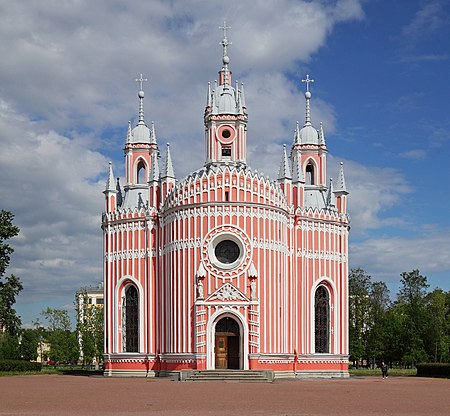Chesme Church

The Chesme Church (Russian: Чесменская церковь; full name Church of Saint John the Baptist at Chesme Palace, also called the Church of the Nativity of St. John the Baptist, Russian: це́рковь Рождества́ Иоа́нна Предте́чи при Че́сменском Дворце́), is a small Russian Orthodox church at 12 Lensoveta Street, in Saint Petersburg, Russia. It was built by the Russian court architect Yury Felten in 1780, at the direction of Catherine the Great, Empress of Russia. A memorial church, it was erected adjacent to the Chesme Palace (Russian: Чесменский дворец: damaged during the Siege of Leningrad and restored in 1946) between Saint Petersburg and Tsarskoye Selo to commemorate the anniversary of Russia's 1770 victory over Turkish forces in Chesme Bay (Turkish: Çeşme) in the Aegean Sea during the Russo-Turkish War of 1768–1774. The church and Chesme Palace were the earliest Neo-Gothic constructions in the St Petersburg area. Considered by some to be St Petersburg's single most impressive church, it is a rare example of very early Gothic Revival influence in Russian church architecture.
Excerpt from the Wikipedia article Chesme Church (License: CC BY-SA 3.0, Authors, Images).Chesme Church
улица Ленсовета, Saint Petersburg
Geographical coordinates (GPS) Address Phone number Website External links Nearby Places Show on map
Geographical coordinates (GPS)
| Latitude | Longitude |
|---|---|
| N 59.856666666667 ° | E 30.330833333333 ° |
Address
Чесменская церковь (Церковь Рождества святого Иоанна Предтечи)
улица Ленсовета 12
196135 Saint Petersburg (округ Звёздное)
Saint Petersburg, Russia
Open on Google Maps






